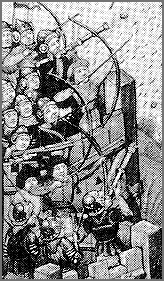
The revolt of Owain Glyndwr
Powys and Owain Glyndwr: 1
 The
modern county of Powys did not exist in 1400; nor even did Breconshire,
Montgomeryshire or Radnorshire. Wales was a patchwork of lordships
and the area now known as Powys consisted of several of these.
But for simplicity’s sake the modern names are used here.
The
modern county of Powys did not exist in 1400; nor even did Breconshire,
Montgomeryshire or Radnorshire. Wales was a patchwork of lordships
and the area now known as Powys consisted of several of these.
But for simplicity’s sake the modern names are used here.Welshpool was one of the first towns that the rebels attacked and burned.
By the autumn, Adam of Usk reported that the whole of north Wales including Montgomeryshire had defected to Owain and were attacking the English and their towns. Defections were also reported at Builth. Henry IV responded with his October expedition and placed garrisons in many castles including Builth, Brecon and Painscastle.
On 22 June 1402 Owain led an expedition into Radnorshire and won a major victory at Bryn Glas, near Pilleth church, capturing Edmund Mortimer.
 (Leland, writing in the 1530s, said that
Owain led a raid into Radnorshire in the summer of 1401 or 1402
and that he "spoiled and defaced" the abbey of Cwm-hir.
Leland goes on to say that local tradition recalled him partly
destroying Radnor castle, and beheading 20 men of the garrison
afterwards, although contemporary English sources do not mention
this raid.) The king immediately took steps to safeguard Radnor
castle and put Brecon castle on alert, a clear indication that
these areas were now within his reach. Edward Charlton was sent
to his castle at Welshpool to counter the rebellion in Montgomeryshire,
and Richard, Lord Grey of Codnor was made the king’s lieutenant
from Aberystwyth to Hay. The English government continued to
raise revenues from estates in Wales with remarkable insensitivity,
and the inhabitants of Brecon were told to pay a "war loan"
of £210 towards Lord Grey’s expenses to avoid having
to dip into the ordinary revenues from the lordship!
(Leland, writing in the 1530s, said that
Owain led a raid into Radnorshire in the summer of 1401 or 1402
and that he "spoiled and defaced" the abbey of Cwm-hir.
Leland goes on to say that local tradition recalled him partly
destroying Radnor castle, and beheading 20 men of the garrison
afterwards, although contemporary English sources do not mention
this raid.) The king immediately took steps to safeguard Radnor
castle and put Brecon castle on alert, a clear indication that
these areas were now within his reach. Edward Charlton was sent
to his castle at Welshpool to counter the rebellion in Montgomeryshire,
and Richard, Lord Grey of Codnor was made the king’s lieutenant
from Aberystwyth to Hay. The English government continued to
raise revenues from estates in Wales with remarkable insensitivity,
and the inhabitants of Brecon were told to pay a "war loan"
of £210 towards Lord Grey’s expenses to avoid having
to dip into the ordinary revenues from the lordship!